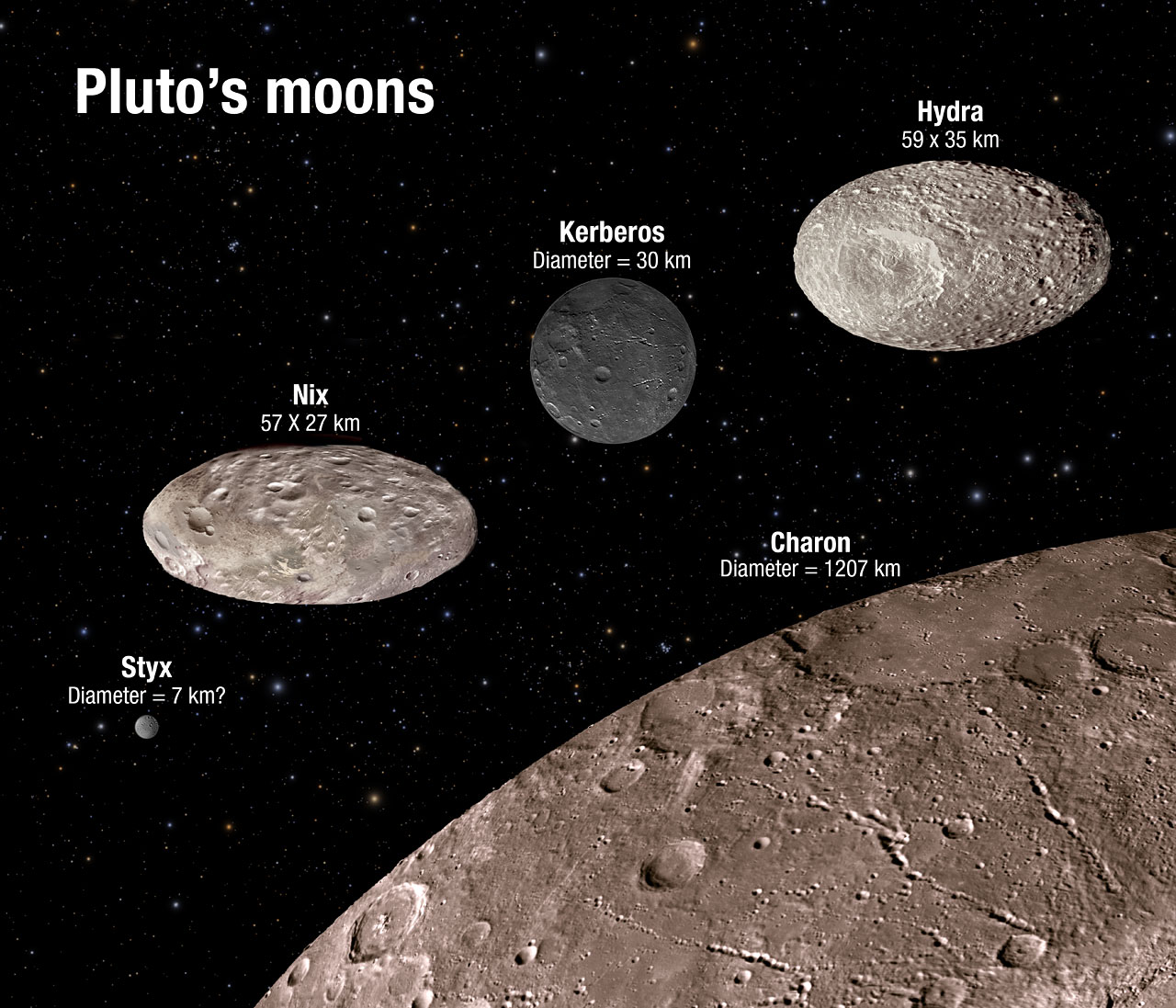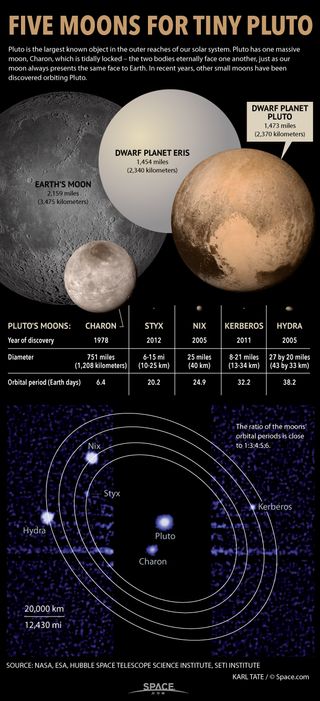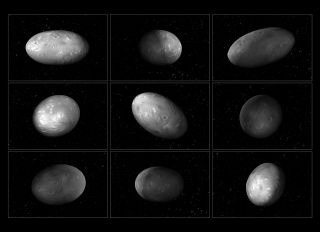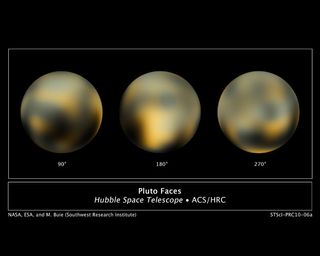
Pluto's moons are even stranger and more intriguing than scientists imagined, a new study reveals.
The Pluto system consists of four tiny satellites — Nix, Hydra, Kerberos and Styx — orbiting a "binary planet" comprised of Pluto and its largest moon Charon, which, at 750 miles (1,207 kilometers) in diameter, is nearly half as wide as the dwarf planet itself.
This binary setup has profoundly influenced the orbits of the four small moons, injecting chaos into their movements — as depicted in a newly released animation of tumbling Nix — in ways not fully appreciated until now, the study suggests. [Photos of Pluto and Its Moons]
"It's a very strange place to live in if you are orbiting a binary planet," lead author Mark Showalter, of the SETI (Search for Extraterrestrial Intelligence) Institute in Mountain View, California, told Space.com.

Brightness and size
Showalter and co-author Douglas Hamilton, of the University of Maryland, analyzed images of the Pluto system taken by NASA's Hubble Space Telescope between 2005 and 2012. (During this period, the observatory discovered all four of the dwarf planet's tiny known moons; Showalter led the teams that detected Kerberos and Styx.)
The two researchers used these photos — which captured brightness variations of the moons over time — and computer models to characterize the four small satellites and their orbits in unprecedented detail.
For example, Showalter and Hamilton derived new brightness and size estimates for the moons. They found that Nix and Hydra are likely about as bright as Charon, which reflects roughly 40 percent of the light that hits it.
Get the Space.com Newsletter
Breaking space news, the latest updates on rocket launches, skywatching events and more!
Before the new study, "we didn't really know how big Nix and Hydra were, because we didn't know how bright they were," Showalter said. "And now, based on our analysis, we actually do pretty well know how big and how bright they are, so there are a lot of uncertainties about the properties of Nix and Hydra that have gone away now."
The Hubble images suggest that Hydra is around 28.2 miles (45.4 km) across, while Nix has a diameter of 24.6 miles (39.6 km) or so. Kerberos and Styx, meanwhile, are probably about 15.4 miles (24.8 km) and 4.2 miles (6.8 km) wide. (These latter two moons are tougher to characterize, because they are fainter than Nix and Hydra.)
These diameter estimates assume a spherical shape for the moons, which is likely not the reality; most if not all of the four tiny satellites are probably ellipsoidal, researchers said.
The duo's analysis also suggests that Kerberos is much darker than its fellow satellites, with a reflectivity of just 4 percent. Whereas Nix and Hydra are basically "dirty snowballs" in terms of reflectivity, "Kerberos is a charcoal briquet," Showalter said. [Pluto's 5 Moons Explained (Infographic)]
This result "took us completely by surprise, because everybody has been assuming all along that the moons would be pretty similar," he added. "They all probably formed at the same time; they all are made of the same stuff."
Astronomers think Pluto's four small moons were formed from the debris scattered by a long-ago giant impact between a proto-Pluto object and a proto-Charon. Perhaps the proto-Charon was a very dark body, and Kerberos is a relatively pristine piece of this original impactor, Showalter said, though he stressed that this idea is mere speculation.

Resonance and chaos
Showalter and Hamilton also determined that Styx, Nix and Hydra are linked by a "resonance," a sort of gravitational sweet spot in which orbits of multiple celestial bodies are related by a ratio of two whole numbers. A similar three-body resonance is found among the Jupiter moons Io, Europa and Ganymede, the researchers said.
"The resonant relationship between Nix, Styx and Hydra makes their orbits more regular and predictable, which prevents them from crashing into one another," Hamilton said in a statement. "This is one reason why tiny Pluto is able to have so many moons."
But there is also quite a bit of chaos in the Pluto system, imparted by the complex and shifting gravitational field of the Pluto-Charon binary.
For instance, Showalter and Hamilton found that Nix and Hydra exhibit chaotic rather than synchronous rotation, meaning they don't always keep the same side facing Pluto-Charon — and that it's very tough to predict their rotational movement. (Nearly every other moon in the solar system, including Earth's, is a synchronous rotator.)
"If you lived on Nix, you would not know if the sun is coming up tomorrow; it is that extreme," Showalter said, adding that models suggest that Styx and Kerberos are chaotic rotators as well. "You'd have days where the sun rises in the east and sets in the north."
Such findings could help researchers better understand the many alien planets that orbit binary stars, researchers said.
"We are learning that chaos may be a common trait of binary systems," Hamilton said. "It might even have consequences for life on planets orbiting binary stars."

New Horizons and beyond
The new study was published online in the journal Nature today (June 3), just six weeks ahead of the first-ever Pluto flyby. On July 14, NASA's New Horizons spacecraft will zoom within 7,800 miles (12,500 km) of the dwarf planet's surface.
New Horizons should get good looks at the surfaces of Nix and Hydra, and the probe's observations will likely reveal how dark Kerberos is, Showalter said.
Data from the flyby, as well as continued long-term monitoring by Hubble and NASA's James Webb Space Telescope, which is scheduled to launch in 2018, could end up bringing Pluto's moons into sharp focus, he added.
"We've got pieces to start fitting together, and maybe eventually out of this we'll get a whole formation scenario for the [Pluto] system," Showalter said.
Follow Mike Wall on Twitter @michaeldwall and Google+. Follow us @Spacedotcom, Facebook or Google+. Originally published on Space.com.
Join our Space Forums to keep talking space on the latest missions, night sky and more! And if you have a news tip, correction or comment, let us know at: community@space.com.

Michael Wall is a Senior Space Writer with Space.com and joined the team in 2010. He primarily covers exoplanets, spaceflight and military space, but has been known to dabble in the space art beat. His book about the search for alien life, "Out There," was published on Nov. 13, 2018. Before becoming a science writer, Michael worked as a herpetologist and wildlife biologist. He has a Ph.D. in evolutionary biology from the University of Sydney, Australia, a bachelor's degree from the University of Arizona, and a graduate certificate in science writing from the University of California, Santa Cruz. To find out what his latest project is, you can follow Michael on Twitter.